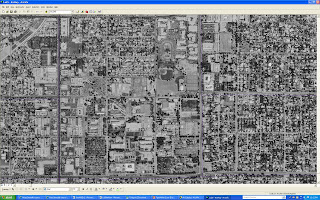Part 1: Complete Ormsby Chapters 7, 18 & 19 and answer the following questions.
I. Chapter 7
1. The information used for dynamic labels comes from where?
The layer Information
2. You are making a map of Los Angeles and have a point layer that shows all the cities in the region. However, you want to show city names for only 3 cities. What is the most efficient way to achieve this?
Clicking on the A in the drawing toolbar and selecting the label button. Then click on what you want labeled and the label will pop up.
3. Can you manually adjust the position of dynamic labels?
Yes, click on the label and drag.
4. Which tool needs to be selected to adjust graphics?
The select elements arrow from the drawing toolbar.
5. What are the two annotation types?
Geodatabase Annotation and Map Document Annotation
II. Chapter 18
1. You can create your own ArcMap templates.
a. True
b. False
2. If you create a map based on an ArcMap template file (.mxt), can you save it as an .mxd file?
Yes
3. Describe two different ways you can access map templates.
One way is when ArcMap opens select the 'A template' option and click OK. The other way is to select the change layout which is the far right button in the Layout toolbox.
4. You are adding five point graphics to your map. Instead of having to change the properties for each one after you add it, you want to set the default point symbol to a size 12 purple star. How do you do this?
Double click on the symbol and select the star icon and change the color in the color box to purple.
5. Describe two different ways you can change the color of a graphic circle.
One way is to go to properties in the layer and in teh sybols tab select the symbol and change the color or double click on the circle in the table of contents and change the color there.
III. Chapter 19
1. What is the first thing you should always do before setting up your map layout?
First thing to do is set the orientation of the paper to either landscape or letter by selecting File>Page Setup
2. Why is the scale different in the data view versus the layout view?
The data view is used to edit so it lets you zoom in and out without changing it in the final product (data view).
3. What are three customization options available for the scale bar?
1. Division Value 2. Number of divisions 3. Division Units
4. Why is it important to use the 1:1(Zoom to 100%) button?
It makes it possible to always view the whole picture instead which makes it easier to evaluate and edit the layout view.
5. Explain how a graphic added to your data view would respond differently compared to a graphic added to the layout view when navigating around your map.
It is connected to the map in data view so when you go to layout view the graphic will not move seperately; it is connected to the map you put it in in data view. Where if you add a picture in layout view it is able to move around by itself.
Part 2.
Q1: Choropleth maps are a type of thematic map. Define what we mean by a choropleth map.
Data with numeric data is put into groups and shaded to show the differences and to the eye can show the larger numbered data compared to the smaller numbered data through differnet color shades.
Q2: Read about layer files in the ArcGIS Desktop Help. Describe their benefits.
References geographic data stored on disk and references data supported by ArcCatalog. This is one of the main benefits because layer files can read almost any source which is very helpful. Layer files are said to be "cartographic view of your geographic data."
Q3: How do layer files differ from layer packages?
Layer files reference geographic data stored on disk and reference most data sources. Where Layer packages is a ready-to-use file containing one map and its data.
Q4: What is the population of City of Long Beach for the year 2000?
461,522
Q5: What is the population for the City of Los Angeles in 2000?
3,694,820
Q6: Using the ArcGIS Desktop Help, describe the three types of hyperlinks that can be created.
Document-this kind will send you to a document, Univorm Resource Locator (URL)-will launch a browser and send you to a web site, and Macro-lets you customize hyperlink behavior.











